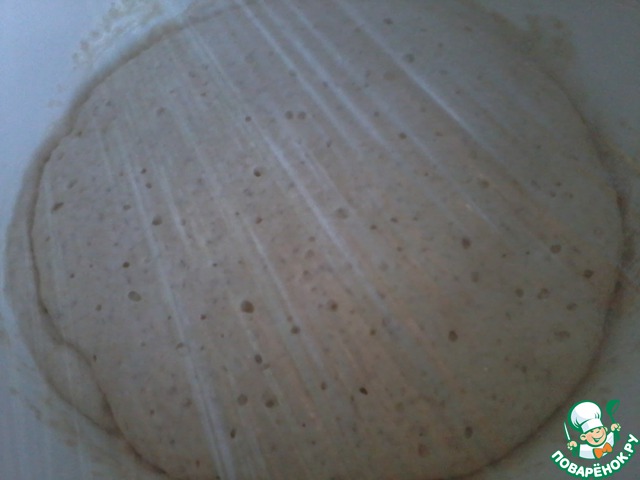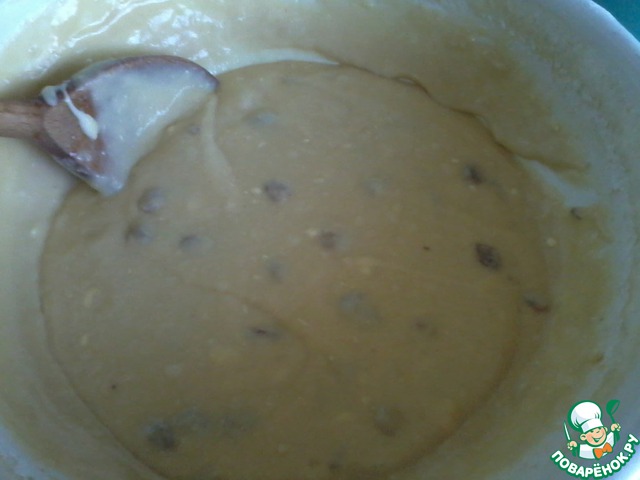Description

I want to offer you to try delicious, dense cake, even after five days it is very tasty. Give a DETAILED description of the PREPARATION of CAKES FOR "BEGINNERS"! This recipe is published at the request of the cook. Cooked this cake a few years - it's very tasty. If you love and want to try the "dense" cake, to - go, I'd be happy!
Ingredients
-
Flour
520 g
-
Yeast
1 pack
-
Milk
125 ml
-
Chicken egg
3 piece
-
Sugar
120 g
-
Honey
2 tsp
-
Vanilla sugar
1 pack
-
Butter
100 g
-
Salt
0.005 tsp
-
Raisins
100 g
Cooking

First I want to say: for preparation and dough and the dough for the cakes took me in the end - 520g flour (all weighed on an electron. scales). Flour is different, so if you put a little bit more (up to 100g),- that the dough doesn't spoil it. Below written tips on baking cakes. So, prepare: dough: 100 g flour sift into a bowl, mix with dry yeast. Pour the warm milk, stir well, the dough will be thick. The bowl cover with cling film, top cover with a towel and put in a warm place for 1 hour.

When the dough has nearly come, you need to separate eggs into yolks and whites. To the yolks add the sugar, vanilla sugar and honey. All good RUB, in the end, add a pinch of salt.

Here is the dough came.

To it gradually add the mixture of yolks, all while well stirring. Then proteins vzbit in a lush foam and add to dough. All stir well.

And add soft butter - stir.

Then add washed and dried on a paper towel raisins. Again a good stir.

Now gradually add the remaining sifted flour in small portions. The flour can add ginger powder to the tip of a knife and a pinch of nutmeg. And knead in the bowl for the dough. It's fat, and almost does not stick to hands and bowl. Don't need excess add flour if the eggs were very large, you can add no more than one handful of flour. The dough should be well knead until smooth, to avoid lumps.

Put the dough in a bowl lightly greased with vegetable oil. Cover it with plastic wrap, with a towel and put in warm place to rise for about 1 hour (1 hour 20 min).

The dough after proofing through the full 1H 20 min.

From test to tear off pieces, podcating them into a ball.

And put into molds for cakes. Fill out forms for cakes are slightly less than half of the total forms. I'm at the bottom of the form put a circle of baking paper to form the paper above the height of the molds with 6 cm be placed in a warm, draft-free place for about 30-35 min. Almost at the same time I turn on the oven to warm up.

When zagotovochki cakes will rise at 2/3 of the height of the molds, put them in a pre-heated oven. Temperature of 180 gr. With no more than 200 gr. With!!

Bake for approximately 35 min of My 40 min was prepared From the specified number of test I have 3 large cakes. The readiness check wooden. wand. The first 25 min (for such big cakes!) the oven is better not to open!!

Finished cakes to cool in the form. I usually just roll them and put on side on a towel to cool.

Here such turned out cakes.

Decorated protein coating: this number of cakes - 1 chilled protein vzbit in a solid, very thick foam and add a half Cup (250ml) powdered sugar. All beat well for a few minutes, then added the juice of one lemon and again all fluffed up. Immediately cover the finished glazurit cakes. Sprinkle with confectionery sprinkles.

Specially cut (2 hours after baking) to show you. The next day he Matures well, it turns out tasty, dense, very rich cake.

It is very well kept. In the photo the cake, which was prepared a week ago at Easter - today, one of the remaining cut - soft, delicious!

TIPS for newbies: 1. YEAST! see the expiration date on the package!!! I always buy a small pack - great outdoor pack can degrade the quality of the yeast. 2. Don't forget the FLOUR sift through a sieve. 3. PRODUCTS - take-all strictly according to the recipe! it is possible to reduce the number of sugar. This cake is allowed to "shift" meal - within reason, of course. It will still work - will increase the proofing time of dough and the cooking time! 4. The DOUGH mix well, let her come! the time depends on room temperature - now a late Easter, warm outside, so the hours she had enough. More hours is not necessary, the dough will settle, so look how it behaves. 5. DOUGH - butter is room temperature, not heat it, otherwise the dough will take more flour. Squirrels just make foam (we don't make meringue). In the yeast mixture gradually add the egg mixture, in all stages of dough - stir it well. The oil left a little pieces, then adding flour - it is good to intervene in the dough. Pour the flour portions. The dough can be left periodically during kneading for 1 minute each time it becomes more pliable and not so sticky. The dough made with milk is always more sticky than water. But when it is a little rest, it becomes much more enjoyable. First, the dough is easier to knead in the bowl, then you can put it on the table (you can LIGHTLY grease it raises. oil) and good to replace him. The prepared dough can be pulled into a braid on the table. But slightly stick to the table will still be. The dough is well kneaded (to make it uniform - a tight ball which you can play football - we don't need!) and put it to come. 6. PROVING the DOUGH - do not rush! give the dough a good increase in volume. For this count of the test will approach the bowl or 3 liter kastrula. At the end of the proofing should cover the entire area of the tank. If a warm day, I put the dough on the window sill to the sun, the top with a towel harboring. In winter, this dough will rise for at least 2 hours. The more sugar, eggs and butter, the more difficult for the yeast to work. And if still cool in the room, then the fermentation process is delayed. Therefore, do NOT RUSH!!! let them rise! 7. FORMING CAKES: well risen dough divide into portions in molds. I have molds factory 800ml 750 ml and 650 ml. I often don't even grease them with oil when not doing bumpers for the height. At the bottom of the tins and put a circle shape piekarska W.. paper (oil not grease the paper I have a good). The dough is divided into three almost equal parts, roll each into a ball, and dipped in form. To flatten the dough does not need! during proofing and baking - test has the property to occupy the entire volume of the form. For this cake form, it is desirable to fill the test mold half or a little less (I always do balls, slightly less than half of the forms) 8. PROVING CAKES - set in warm (I'm in the sun, on top of easy cuisine. towel) and wait, the dough should rise to occupy 2/3 of the height of the molds. Again, the proofing time depends on the temperature and density of the dough. Do not forget to turn on the oven to warm up. 9. BAKING CAKES - check the oven, may need a little less fire. Put the tins with the cakes on the middle shelf in the oven: temp.180-200 gr. C. Periodically, without opening the oven monitor the temperature. Small cakes can be ready in about 20 min acrivate the door earlier, you still do this test will not help! Small cakes to check for readiness after 20 minutes, large 30-35 min. to Pierce with a toothpick or skewer trees. for the skewers - it should remain dry! Finished cakes can be left in the form or give them a little to cool and gently spread roll out on a towel. If there is no experience - better to leave cake to cool in the form. Freshly baked cake is very SOFT!! can break, especially in tall thin forms. GOOD LUCK WITH THE CAKES!!! If you have any questions, I will answer all with pleasure!!!





Leave a comment or a recipe review
Leave comments can only registered users.
Register, or Login if you are already registered.